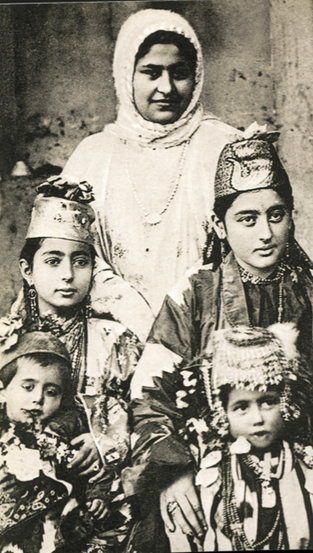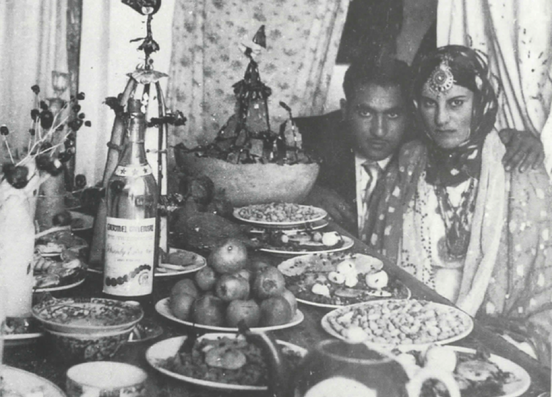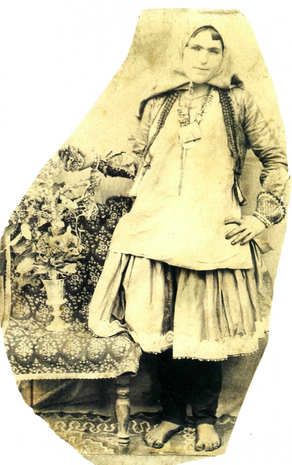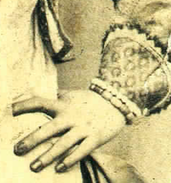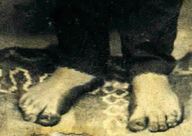If you are interested in having a traditional Jewish henna ceremony, for a marriage or for any other happy occasion, or interested in having me speak to a group about Jewish henna traditions, please contact me!
See here for an overview of Jewish henna traditions in general, and Jewish henna in Israel today.
This information is the result of my own research. Please do not copy this information without proper citation.
See here for an overview of Jewish henna traditions in general, and Jewish henna in Israel today.
This information is the result of my own research. Please do not copy this information without proper citation.
Jewish Henna Traditions among Persian Jews
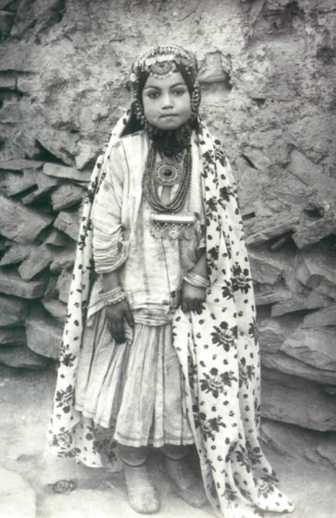
Jewish village girl shortly after her wedding, Iran, ca. 1875
The Jewish community in Central Asia is very ancient: by the middle of the first millenium BCE there was already a substantial settlement of Jews in the Persian Empire. Several communities, speaking a variety of Judeo-Persian languages, were established in what is today Iran and Afghanistan; others spread to the north into Bukhara (today Uzbekistan and Tajikistan) and to the west into the Caucasus (Georgia, Armenia, and Azerbaijan). These communities share some common cultural and linguistic markers with each other, but also differ in significant ways.
The henna customs of Kurdish Jewish communities living in Persia are discussed, together with other Kurdish Jews, here.
In Persian Jewish communities, henna was an important cosmetic, forming one of the haft qalam arayesh ['seven items of beautification']. It was commonly used by men and women to colour hair, and especially to cover greying hair. Women also used it to colour fingernails and toenails in lieu of nail polish.
Hands and feet were dyed with henna, either solidly or with patterns. The patterns, applied with a stick or even one's fingertips, depended on what each person wanted: common simple designs included dots, stars and moons, and those more artistically inclined would depict flowers, birds, and even people. Among Persian Jews, the henna was applied by women of the community, rather than professional artists. Henna was generally applied in the hammam [public baths]: women would usually go to the hammam to be hennaed around once a month, generally on a Friday morning before preparing for Shabbat. Women and their children would spend three to four hours in the hammam, which was an important social institution: besides bathing, and being hennaed or massaged, they would socialize, gossip, tell jokes, and catch up on community news.
The henna customs of Kurdish Jewish communities living in Persia are discussed, together with other Kurdish Jews, here.
In Persian Jewish communities, henna was an important cosmetic, forming one of the haft qalam arayesh ['seven items of beautification']. It was commonly used by men and women to colour hair, and especially to cover greying hair. Women also used it to colour fingernails and toenails in lieu of nail polish.
Hands and feet were dyed with henna, either solidly or with patterns. The patterns, applied with a stick or even one's fingertips, depended on what each person wanted: common simple designs included dots, stars and moons, and those more artistically inclined would depict flowers, birds, and even people. Among Persian Jews, the henna was applied by women of the community, rather than professional artists. Henna was generally applied in the hammam [public baths]: women would usually go to the hammam to be hennaed around once a month, generally on a Friday morning before preparing for Shabbat. Women and their children would spend three to four hours in the hammam, which was an important social institution: besides bathing, and being hennaed or massaged, they would socialize, gossip, tell jokes, and catch up on community news.
|
Aside from the general use of henna, women would also apply henna before holidays and celebrations as a sign of joy and beauty. As a symbol of celebration, henna was not used during periods of mourning, both personal and communal; henna was not used, for example, during the month of Av [a month mourning the destruction of the Temple].
The crypto-Jews of Mashhad (who had been forced to convert to Islam in the mid-19th century, but continued to practice Judaism in secret) also refrained from using henna during the two months of Muslim mourning [i.e. Ramadan, a month of repentance, and Muharram, a month of Shi’i mourning for the martyrdom of Husayn ibn Ali] when henna is traditionally not done in Muslim communities, as to not draw attention to themselves. In some Iranian Jewish communities, after someone died, their family would refrain from henna for a full year. At the end of the year, the mourners would be symbolically brought out of their grief: friends and family members would bring gifts of new clothing and jewelry and place them on the mourners; they would then be taken to the hammam and hennaed, which symbolized their return to the cycle of life and sociality. This ceremony was called sal dar overi [literally, ‘to leave the year’, i.e. to end the year of mourning]. |
|
The henna ceremony done before marriage was known in Persian Jewish communities as hanabandan or hanabandon (literally, 'tying the henna'). While in former years elaborately patterned henna was popular, by the early 20th century many Jewish brides (especially those in large cities like Herat, Kabul, Tehran, or Isfahan) preferred just to have their palms hennaed solidly or even just one finger.
The henna ceremony generally took place in the evening of the day before the wedding. In the morning, both the bride and the groom had gone (separately) to the hammam. The groom had his hair cut and his beard trimmed, while the bride had her eyebrows threaded and any body hair depilated. They were presented with sweets, dried fruit, and sharbat [a sweet chilled drink] amid singing and celebration. The bride was presented with jewelry and they hennaed her hair (and sometimes her hands and feet as well). In the evening, the central henna ceremony was performed in the bride's house. The henna was seen as protecting the bride and groom as well as contributing to their beauty. The henna was brought from the groom's house in a decorated brass bowl (called a tashtak), and placed on a special small table known as khanche-ye hana ['the henna tray'] along with candles, sweets, fruit, and a sugar cone wrapped with colourful ribbons. Traditionally the groom would have held a smaller, separate ceremony in his own home; as in Yemen, the chief rabbi (mulla) was given the honour of spreading the first henna on the groom's hands, followed by the groom's father. In more recent years the groom simply accompanied the bride to her house and the two ceremonies were joined. In Bukhara and Samarkand, it was common for the groom to have only his pinkie finger hennaed, while the bride was hennaed on her hands and feet. The groom's ceremony was known as shab-e jubanan ['the night of the bachelors']. |
A special cloth known as pishandaz-e hana ['the henna cloth'] was spread over the laps of the bride and groom, and their hands were hennaed, as the guests chanted certain well-known songs for the ceremony (such as 'Arus hana mibande' [The bride is being hennaed'] or 'Emshab shab-e hana bandan-e' ['Tonight is the night of tying henna']). The guests sang and danced, food was served, and the festivities often lasted well past midnight. In Bukhara, there was a special rice pilaf served for the occasion.
When the henna had dried and the couple was ready to go to sleep, the henna was wrapped up in special cloths known as hanaband ['tying cloths'], and tied with ribbons (saghpich), hence the name of the ceremony.
When the henna had dried and the couple was ready to go to sleep, the henna was wrapped up in special cloths known as hanaband ['tying cloths'], and tied with ribbons (saghpich), hence the name of the ceremony.
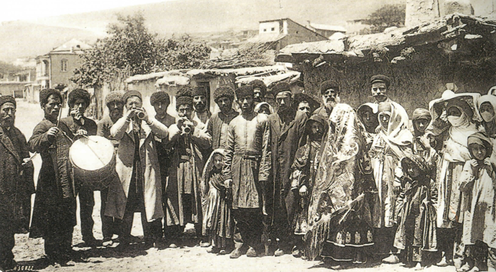
Mountain Jews celebrating a wedding, Quba, Azerbaijan, early 20th century.
Among the Mountain Jews of Azerbaijan, the ceremony was known in Juhuri [Judeo-Tat] as hina yakhte ['putting on the henna'].
They prepared the henna in a bowl with a needle (to ward off the evil eye) and a silver coin (to bring prosperity). After the bride was hennaed on her hands and feet, the plate was passed around on a tray and the guests hennaed their fingertips. The brothers of the bride were responsible for carrying the tray around and soliciting money from the guests as presents for the bride.
The henna was a symbol of prosperity and happiness; in fact, a popular blessing was to wish someone adasoitu hina veravo, 'May your hands soon be hennaed'. Following the henna, Azerbaijani Jews held a unique ceremony known as benigoru ['the reminder'], where the names of all the relatives, living and deceased, were recited, and prayers were sung mourning the destruction of the Temple in Jerusalem and the exile from the Land of Israel.
The henna ceremony was also practiced in some parts of Georgia until the early 20th century. Joseph Judah Chorny, a Russian traveller who visited Georgia in the 1860s, describes it: "At midnight [in Akhaltsikhe, southern Georgia] many men and women go to the bride’s house, carrying wax candles... and one tray filled with a dye called ina... and this is the red dye which with the bride must colour her fingernails and palms. All the women must dip their fingers in this dye, and they give the shamash [sexton] some money according to their ability, and they say besiman tov ['congratulations']! When the bride dyes her hands, many women and girls sit around her and two loaves of bread are placed on her head and in them are placed two burning candles. When the colour has set, the bread and candles are taken off her head, and the women sing and dance before the bride and entertain her". This ceremony, according to Chorny, was similarly practiced in Kareli, central Georgia.
They prepared the henna in a bowl with a needle (to ward off the evil eye) and a silver coin (to bring prosperity). After the bride was hennaed on her hands and feet, the plate was passed around on a tray and the guests hennaed their fingertips. The brothers of the bride were responsible for carrying the tray around and soliciting money from the guests as presents for the bride.
The henna was a symbol of prosperity and happiness; in fact, a popular blessing was to wish someone adasoitu hina veravo, 'May your hands soon be hennaed'. Following the henna, Azerbaijani Jews held a unique ceremony known as benigoru ['the reminder'], where the names of all the relatives, living and deceased, were recited, and prayers were sung mourning the destruction of the Temple in Jerusalem and the exile from the Land of Israel.
The henna ceremony was also practiced in some parts of Georgia until the early 20th century. Joseph Judah Chorny, a Russian traveller who visited Georgia in the 1860s, describes it: "At midnight [in Akhaltsikhe, southern Georgia] many men and women go to the bride’s house, carrying wax candles... and one tray filled with a dye called ina... and this is the red dye which with the bride must colour her fingernails and palms. All the women must dip their fingers in this dye, and they give the shamash [sexton] some money according to their ability, and they say besiman tov ['congratulations']! When the bride dyes her hands, many women and girls sit around her and two loaves of bread are placed on her head and in them are placed two burning candles. When the colour has set, the bread and candles are taken off her head, and the women sing and dance before the bride and entertain her". This ceremony, according to Chorny, was similarly practiced in Kareli, central Georgia.
Sources and References:
Baer, Leah. 2002 Life’s Events: birth, bar mitzvah, weddings, and burial customs. In Esther’s Children: a portrait of Iranian Jewry, ed. Houman Shashar.
Bar‘am-Ben-Yosef, No‘am (ed.). 1997 Bo-i kala: minhagei erusin vehatuna shel yehudei afganistan [Draw near, O Bride: Rituals for betrothal and marriage of the Jews of Afghanistan].
Ben-Zion, Yehoshua‘. 1973 Hatuna yehudit beAfganistan [The Jewish wedding in Afghanistan]. Shevet ve‘Am, Vol. 2, No. 7.
Brauer, Erich. 1942 The Jews of Afghanistan: An Anthropological Report. Jewish Social Studies, Vol. 4, No. 2.
Chorny, Joseph Judah. 1884 Sefer hamasa‘ot be’ereṣ qavqaz [The Book of Journeys in the Caucasus].
Goldin, Farideh. 2004 Wedding Song: memoirs of an Iranian Jewish woman.
Kort, Zevulun. 1971 Minhagei erusin venissu’in beHerat Afganistan [Rituals of betrothal and marriage in Herat, Afghanistan]. Yeda’ ’Am, Vol. XV, No. 37/38.
Loeb, Lawrence. 1977 Outcaste: Jewish Life in Southern Iran.
Mikdash-Shamailov, Liya. 2002 Mountain Jews: customs and daily life in the Caucasus.
Mizrahi, Hanina. 1959 Yehudei Paras [The Jews of Persia].
Moshavy, Barukh. 1974 Minhagim ufolqlor shel yehudei Bukhara, beAsya hatikhona bemea hatesha‘ ‘esre: leida, shidukhin, nissu’in, avelut, veshonot [Customs and Folklore of the Jews of Bukhara, in 19th century Central Asia: birth, engagement, marriage, mourning, and miscellaneous].
Patai, Raphael. 1997 Jadid al-Islam: the Jewish “new Muslims” of Meshhed.
Pozailov, Giyora. 1993 Yahadut Bukharah: Gedoleha uminhageha [Bukharian Jewry: Its Sages and Customs].
Sahim, Haideh. 2002 Seven Steps to Beauty. In Esther’s Children: a portrait of Iranian Jewry, ed. Houman Shashar.
Bar‘am-Ben-Yosef, No‘am (ed.). 1997 Bo-i kala: minhagei erusin vehatuna shel yehudei afganistan [Draw near, O Bride: Rituals for betrothal and marriage of the Jews of Afghanistan].
Ben-Zion, Yehoshua‘. 1973 Hatuna yehudit beAfganistan [The Jewish wedding in Afghanistan]. Shevet ve‘Am, Vol. 2, No. 7.
Brauer, Erich. 1942 The Jews of Afghanistan: An Anthropological Report. Jewish Social Studies, Vol. 4, No. 2.
Chorny, Joseph Judah. 1884 Sefer hamasa‘ot be’ereṣ qavqaz [The Book of Journeys in the Caucasus].
Goldin, Farideh. 2004 Wedding Song: memoirs of an Iranian Jewish woman.
Kort, Zevulun. 1971 Minhagei erusin venissu’in beHerat Afganistan [Rituals of betrothal and marriage in Herat, Afghanistan]. Yeda’ ’Am, Vol. XV, No. 37/38.
Loeb, Lawrence. 1977 Outcaste: Jewish Life in Southern Iran.
Mikdash-Shamailov, Liya. 2002 Mountain Jews: customs and daily life in the Caucasus.
Mizrahi, Hanina. 1959 Yehudei Paras [The Jews of Persia].
Moshavy, Barukh. 1974 Minhagim ufolqlor shel yehudei Bukhara, beAsya hatikhona bemea hatesha‘ ‘esre: leida, shidukhin, nissu’in, avelut, veshonot [Customs and Folklore of the Jews of Bukhara, in 19th century Central Asia: birth, engagement, marriage, mourning, and miscellaneous].
Patai, Raphael. 1997 Jadid al-Islam: the Jewish “new Muslims” of Meshhed.
Pozailov, Giyora. 1993 Yahadut Bukharah: Gedoleha uminhageha [Bukharian Jewry: Its Sages and Customs].
Sahim, Haideh. 2002 Seven Steps to Beauty. In Esther’s Children: a portrait of Iranian Jewry, ed. Houman Shashar.
Pictures from:
Bar‘am-Ben-Yosef, No‘am (ed.). 1997 Bo-i kala: minhagei erusin vehatuna shel yehudei afganistan [Draw near, O Bride: Rituals for betrothal and marriage of the Jews of Afghanistan].
Shashar, Houman (ed.). 2002 Esther’s Children: a portrait of Iranian Jewry.
Sylvain, Gerard. 1980 Images et traditions juives: un millier de cartes postales (1897-1917) pour servir à l'histoire de la diaspora [Jewish images and traditions: a thousand postcards (1897-1917) to serve for the history of the diaspora].
Shashar, Houman (ed.). 2002 Esther’s Children: a portrait of Iranian Jewry.
Sylvain, Gerard. 1980 Images et traditions juives: un millier de cartes postales (1897-1917) pour servir à l'histoire de la diaspora [Jewish images and traditions: a thousand postcards (1897-1917) to serve for the history of the diaspora].
